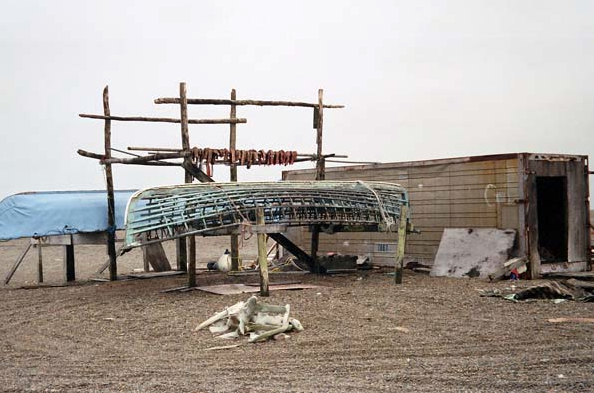Crafting Walrus-Skin Boats
The captain bent over the bow of his walrus-skin angyapiget frame. Like other Eskimo master boat builders and ship captains in his village, he needed to recover his craft every three or four years. He always used hides from female walruses because they were smoother, more flexible and easier to work with than the skins from older bulls.
The basic design of his skinboat had remained essentially the same for centuries. It looked like a large, round-bottomed canoe, measuring 20-25 feet long and five to six feet wide, and weighed just 500 pounds, light enough for him and his crew to drag across the ice when necessary. The walrus skin served as an ideal material for the hull, strong enough to carry big loads, up to 25 people and five tons of cargo, but flexible enough to withstand harsh water and weather conditions.
Because walrus catches had declined in recent years, traditional boat building in his village had followed suit. Gambell, Alaska, for example, had 22 walrus-skin boats in 1989 but, as of 2005, only 10 remained. The process required not only know-how but also time and patience.
The five men grunted as they wheeled the first heavy, water-logged hide from the pond to the waiting boat frame. The captain had soaked the two split hides for the past nine days so they’d be easier to stretch and sew. The men tipped the skin out of the wheelbarrow onto a waiting blanket and went back for the second. They positioned this load as close as they could to the first and dumped it out. With two men lifting each side, they maneuvered the two hides close to each other, pulling at the edges until they overlapped.
The captain’s wife and the other village skinsewers sat down on folded blankets and scooched underneath the heavy skins. They steadied the flexible material and grabbed the nearest edge. They stitched the top layer using thread twisted and braided from whale sinew (tendon). After each few stitches, they greased the thread with blubber and spread it on the seam for extra waterproofing. Then, with help from the men, the women flipped the now brown skin over and sewed the seams flat to make them watertight.
Now one large hide, weighing perhaps 500 pounds, the men maneuvered it bit by bit onto the hull. They put the tougher blubber side toward the front of the boat, which took more punishment, and the skin side toward the rear. When they’d managed to get it roughly in place, they tied the skin off loosely with sealskin lashes that they looped over the edges. Then, together, the men stretched the hide. They worked their way around the upside-down wood frame, pulling first one side of the skin and then drawing the opposite side taut. When they’d gone once around, the captain marked where he’d need to cut out for the engine. Instead of having it at the back, where water could splash over and flood it, skinboats put the motor in the middle, to protect it. With a razor, he sliced the hide alon g his markings and pushed through. He lashed these new pieces onto the frame and the men began the stretching process once again. A few days later, after the air had slowly dried the skin to its final tautness, the captain inspected the boat. Now for the final touches. He dipped his brush into a can of light blue paint. Unlike in his father’s day, or even in some other communities, he took advantage of the availability of marine paints to preserve the longevity of the boat. With even strokes, he coated the outside of the hull, enjoying the deliberate movements. The old and the modern. Could he maintain the best of both worlds?
Learn more…
How many skins does it take to make one boat? It takes two split skins to cover the frame of one skinboat.
What is a walrus-hide boat called? Angyapiget is the traditional walrus-hide hunting boat in the Siberian Yupik language. In the Inupiaq language, it is called an umiak.
How has the design of skinboats changed over time? Prior to the 1930s, skinboats had flat bottoms and were made from driftwood. Since then, the hulls have rounded bottoms and frames are made from commercially -milled hardwood (e.g., hickory or oak). In addition, marine paints and commercial sealants are now used as a way to preserve the longevity of the skins.

